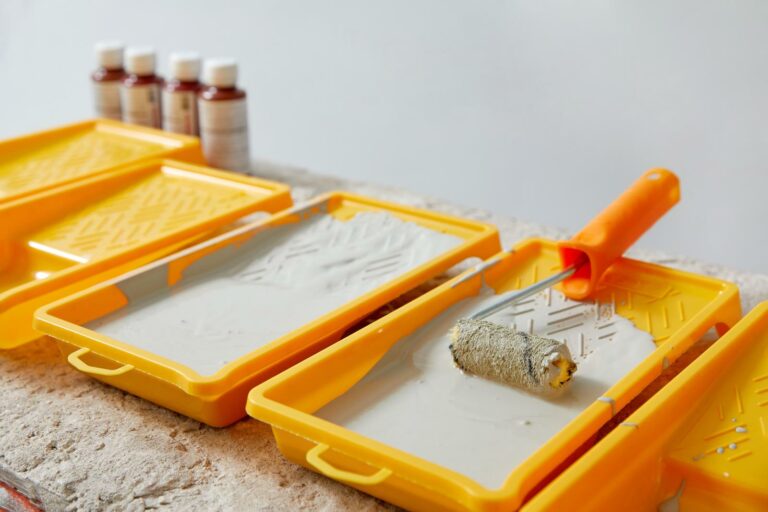Chemical-Free Indoor Paint Alternatives, What Pros Say
Are you tired of indoor paints full of chemicals that may be hazardous to your health? Well, it’s time to put your worries aside because I have the perfect solution for you! I’ve discovered a range of chemical-free indoor paint alternatives that protect your health and contribute to a better environment.
Chemical-free indoor paint alternatives:
Chemical-free indoor paint alternatives include natural and water-based paints like milk and chalk paint, produced by eco-friendly brands such as Ecos Paints and BioShield. Homemade options like flour paint and limewash can also provide a healthier, environmentally friendly choice for home renovations and DIY projects. These alternatives reduce VOCs and promote better air quality.

Discover the world of chemical-free indoor paint alternatives for a healthier, eco-friendly home makeover. Learn about natural ingredients, benefits, and techniques to transform your space. Read on!
Contents
- 1 Eco-friendly Indoor Paint Options without Chemicals
- 2 Are There Any Paints Free of Chemicals?
- 3 Exploring the Existence of No-VOC Paints
- 4 Understanding the Safety of Zero-VOC Paints
- 5 Discovering the Name of Non-Toxic Paints
- 6 Choosing Safe and Non-Toxic Paint for Bathrooms
Eco-friendly Indoor Paint Options without Chemicals
Indoor Air Quality (IAQ) has become a growing concern for many people, especially in homes and offices. One of the most significant contributors to poor air quality is the toxic chemicals known as Volatile Organic Compounds (VOCs) commonly found in standard paints.
As an experienced professional in eco-friendly construction materials, I know that selecting the right chemical-free indoor paint alternatives can be a game-changer for both your health and the environment.
• Natural and Water-Based Paints
One of the most popular and readily available chemical-free paint alternatives is natural or water-based paint. These paints use water as the primary solvent and often contain natural pigments derived from plants, minerals, and clay.
They are free from VOCs, solvents, and other harmful chemicals found in conventional paints, making them a safe and eco-friendly choice for your home.
– Milk Paint
Milk paint, made from a mixture of milk protein (casein), lime, and pigment, is an excellent example of an all-natural paint. It is durable, long-lasting, and has a unique matte finish due to its natural components.
Moreover, it is biodegradable and can be easily cleaned up with water, making it an environmentally friendly alternative.
I recommend using The Real Milk Paint Co. products, as they offer a wide range of colors and are user-friendly for both beginners and professionals.
– Chalk Paint
Chalk paint is another popular natural paint option, made from water, calcium carbonate, and pigment. It has a unique, chalky texture that provides excellent coverage and adheres well to a wide range of surfaces, including wood, stone, and metal.
Chalk paint is easy to apply and does not require any primer or fancy brushes, which makes it an ideal choice for DIY projects.
For the best quality and performance, I suggest Annie Sloan Chalk Paint, as their products are VOC-free and come in multiple unique shades.
• Eco-Friendly Paint Brands
Some paint manufacturers specialize in eco-friendly and chemical-free indoor paint alternatives. These brands specifically focus on producing paints with low to no VOCs and chemicals. They often use sustainable and environmentally friendly sources of ingredients in their products.
– Ecos Paints
Ecos Paints is a popular eco-friendly paint brand that offers a wide range of zero-VOC and odorless paint solutions, including interior, exterior, and specialized products. All their paints are water-based and made from organic, natural materials, ensuring a safe and healthy living space.
Find more information on their product range at the Ecos Paints official website.
– BioShield
BioShield is another eco-friendly paint brand providing natural, solvent-free, and low-odor paint options. Their products are derived from renewable resources like plants, minerals, and clay and are free from synthetic chemicals or VOCs.
To explore their chemical-free paint alternatives, visit the BioShield website.
• Homemade Paint Alternatives
For those who want complete control over the ingredients used in their paint, making your own all-natural paint using simple and readily available ingredients can be a great option.
– Flour Paint
Flour paint is an affordable and chemical-free alternative made by combining flour, water, boiled linseed oil, pigment, and a natural binder like cellulose. It can be easily prepared at home and customized by adding different pigments for a desired color.
– Limewash
Limewash is a natural, chemical-free paint alternative made by mixing water, lime, and pigment. It offers excellent coverage and has antimicrobial properties due to the naturally occurring lime. This makes it a great option for people prone to allergies, asthma, or chemical sensitivities.
In conclusion, opting for chemical-free indoor paint alternatives not only benefits the environment but also promotes better air quality and healthier living spaces. The options listed in this article are tried and tested alternatives that I personally recommend.
By choosing these eco-friendly paints, you can create a beautiful and healthy home while making a positive impact on the environment.
Are There Any Paints Free of Chemicals?
• Understanding Paint Components
Paint, at its most basic, consists of three main components: the pigment, the binder, and the solvent. The pigment provides the color, the binder holds the pigment particles together and helps them adhere to the surface being painted, and the solvent thins the paint and makes it easier to spread.
Some paints also contain additives to enhance their performance, such as drying agents, stabilizers, or mold inhibitors.
Traditional paints have typically contained a variety of chemicals, including volatile organic compounds (VOCs) and other potentially hazardous substances.
However, in recent years, concerns about the health and environmental impacts of these chemicals have led to the development of more eco-friendly alternatives.
• Natural Paints: A ‘Chemical-Free’ Option?
Some paint manufacturers now offer “natural paints,” which are made with plant-based, mineral, or other natural ingredients. These paints are often marketed as “chemical-free” or “non-toxic,” but it’s important to understand that these terms can be misleading.
In fact, even natural substances are made up of chemical compounds, so it’s impossible for a paint to be truly chemical-free.
However, natural paints do tend to have significantly fewer harmful chemicals than conventional paints. For example, they generally contain minimal or no VOCs, which can contribute to poor indoor air quality and cause respiratory problems, headaches, or other health issues.
Some commonly used natural ingredients in paints include:
- Plant-based binders: Plant-derived oils, like linseed, hemp, or soybean oil, can be used as paint binders. These natural oils are renewable resources and can be less harmful than synthetic binders made from petrochemicals.
- Natural pigments: Some natural paints use pigments made from minerals or plant-based materials. For example, clay paints use earth pigments, which are derived from naturally occurring minerals. These natural pigments can produce a wide range of colors, but they may not be as vibrant or durable as synthetic pigments.
- Water-based solvents: Natural paints often use water as a solvent instead of the more harmful petroleum-based alternatives found in traditional paints. This can help reduce the overall environmental impact of the paint and improve indoor air quality.
One reputable source of information about natural and eco-friendly paints is Green Seal, a nonprofit organization that provides certification for environmentally responsible products.
• Low-VOC and Zero-VOC Paints
In addition to natural paints, another alternative to conventional paints is low- or zero-VOC paints. These products have been formulated to emit minimal or no VOCs, which can help improve indoor air quality and reduce health risks associated with traditional paints.
Low-VOC paints typically contain less than 50 grams of VOCs per liter, while zero-VOC paints contain even lower levels, typically 5 grams or less per liter.
Some zero-VOC paints may still contain trace amounts of VOCs due to the use of pigments, so it’s essential to carefully read product labels and certifications to ensure you’re choosing the most environmentally friendly option.
Many paint manufacturers now offer low- and zero-VOC options as part of their standard product lines. These products are often comparably priced to conventional paints, making them an accessible option for consumers looking to minimize harmful chemicals in their homes.
• Tips for Choosing an Eco-friendly Paint
If you’re interested in finding a paint with fewer harmful chemicals, consider the following tips:
- Look for reputable certifications: Choose paints that have been certified by organizations like Green Seal or the Environmental Protection Agency’s (EPA) Safer Choice Program. These certifications can help ensure that the paint meets specific standards for health and environmental safety.
- Read product labels: Check the labels of potential paint choices to see if they provide information about VOC content or other chemicals. Look for low- or zero-VOC options, or consider natural paints made with plant- or mineral-based ingredients.
- Research the manufacturer: It’s essential to research the paint manufacturer to ensure they have a commitment to sustainability and eco-friendly practices. A reputable company should have information about its environmental initiatives available on its website.
- Consider durability and performance: While some eco-friendly paints may have limited color options or reduced longevity compared to conventional paints, many high-quality options on the market perform just as well as their traditional counterparts. Be sure to research product reviews and comparisons to find a paint that meets your needs and has appropriate durability and performance.
In conclusion, while no paint is genuinely chemical-free, there is a growing selection of more eco-friendly and health-conscious alternatives available.
By choosing natural paints, low- or zero-VOC paints, and paying attention to certifications and manufacturer practices, you can make informed choices that help minimize the harmful chemicals in your home and reduce your environmental impact.
Exploring the Existence of No-VOC Paints
When it comes to painting our homes, we have come a long way in terms of the products available on the market.
One such development is the introduction of low VOC (volatile organic compounds) and no VOC paint options. These paints are marketed as healthier and more environmentally friendly alternatives to traditional paints. But is there really such a thing as no VOC paint?
• Understanding VOCs and Their Impact
Volatile organic compounds (VOCs) are chemicals found in many household products and materials. VOCs are released as gases and can have negative effects on both indoor air quality and human health.
Traditional paints tend to have high concentrations of VOCs, which can lead to several health issues upon prolonged exposure.
The United States Environmental Protection Agency (EPA) has emphasized the importance of reducing indoor VOC levels to minimize health risks.
• How Low is Low VOC Paint?
In response to growing concerns over VOCs, paint manufacturers started developing low-VOC and non-VOC paints. Low VOC paints usually contain fewer VOCs than their traditional counterparts, although the exact definition of “low” can vary.
The EPA sets the standard for acceptable VOC levels in paint as below 250 grams per liter (g/L) for flat finishes and 380 g/L for other finishes.
However, not all low-VOC paints are created equal. Some low-VOC paints still emit a considerable amount of VOCs, while others can achieve near-zero emission levels. It’s essential to read the product specifications and compare VOC content across different brands before making a decision.
• The Truth About No VOC Paint
The term “no VOC” is often used for marketing paint products with negligible VOC content. However, it’s crucial to understand that no product can be entirely free of VOCs. Even the lowest VOC content paints will have trace amounts, often at levels too small to impact human health or indoor air quality.
It’s also important to note that the colorants added to the base paint can also contain VOCs. No VOC paints might advertise their base paint as containing no or negligible amounts of VOCs, but this claim might no longer hold true once colorants are added.
To minimize VOCs, opt for light-colored paints, as they generally require less colorant.
• Green Seal and Other Certifications
To help you make a more informed decision when shopping for low or no-VOC paint, look for third-party certifications. One such organization is Green Seal, a non-profit that sets environmental standards for various products, including paints.
Green Seal Standard GS-11 for paints and coatings outlines strict requirements for VOC content, hazardous substances, and performance.
Similarly, the Master Painters Institute (MPI) offers its own certification for environmentally friendly paints, known as MPI Green Performance Standard. These certifications serve as an excellent starting point for understanding a paint product’s environmental and health-related impacts.
• Expert Recommendations for Choosing Low and No VOC Paints
Based on my experience, here are some recommendations for selecting low and no-VOC paint products:
- Research and compare VOC content: Don’t just rely on marketing claims. Ensure you are reading the product’s specifications to understand the actual VOC content.
- Look for certifications: Trustworthy third-party certifications (such as Green Seal) can help you make a more informed decision, ensuring that the paint meets certain environmental and performance standards.
- Opt for light colors: As the colorants can contain VOCs, opting for lighter colors can reduce the overall VOC content of the final paint mix.
- Consider performance and durability: While low VOC paints have become increasingly popular, they may not perform as well as traditional paints, particularly in terms of durability and coverage. Read customer reviews and consult with professionals to find a paint that strikes the right balance between low VOC content and high-quality performance.
• Final Thoughts
Is there such a thing as absolutely no VOC paint? The truth is that even the most eco-friendly paint will likely contain trace amounts of VOCs.
However, by understanding the importance of VOC content, comparing product specifications, and exploring third-party certifications, you can make a more informed decision that will yield aesthetic results and promote healthier indoor air quality.
Understanding the Safety of Zero-VOC Paints
The world has been increasingly shifting towards eco-friendly and sustainable solutions for various aspects of daily life. One such environmentally conscious choice is the use of zero VOC (volatile organic compounds) paint in homes and commercial buildings.
As more people become aware of the potential health risks and environmental impact associated with traditional paints, it’s essential to understand whether zero VOC paints are truly non-toxic and a safer alternative.
• What Are VOCs and Their Impact?
Volatile organic compounds (VOCs) are organic chemicals that readily evaporate at room temperature, releasing potentially harmful gases into the air. They can be found in a variety of everyday products, including paints, solvents, cleaning supplies, and personal care products.
The United States Environmental Protection Agency (EPA) has identified several possible short and long-term health effects of exposure to VOCs, such as headaches, nausea, respiratory issues, and even liver or kidney damage.
Additionally, VOCs contribute to air pollution, specifically the formation of ground-level ozone or smog, which can lead to further health problems and environmental damage.
• What Is Zero VOC Paint?
Zero VOC paint refers to paint formulations designed to have negligible or no volatile organic compounds. These paints emit significantly fewer harmful chemicals compared to conventional paints, which typically contain high levels of VOCs.
As a result, zero VOC paints aim to reduce indoor air pollution levels and create healthier living spaces.
• Is Zero VOC Paint Non-Toxic?
Although zero VOC paint is marketed as a safer and environmentally friendly option, it doesn’t necessarily translate to being entirely non-toxic.
First, it’s important to note that the term “zero VOC” is often used loosely by manufacturers. According to the EPA’s definition, a paint product labeled as zero VOC should contain no more than 5 grams of VOCs per liter.
However, this threshold allows for trace amounts of VOCs to be present in the paint, potentially leading to some level of toxic emissions.
Moreover, some zero VOC paints may still contain small amounts of harmful chemicals that aren’t classified as VOCs. In other words, the absence of VOCs in a paint product doesn’t guarantee it is free of all toxic substances.
Lastly, the addition of colorants to the base paint may introduce VOCs or other toxic compounds, even if the base paint was initially labeled as zero VOC. Therefore, it’s essential to pay attention to not only the base paint but also the colorants used.
• Choosing Safer Paint Options
While it’s clear that zero VOC paint may not be entirely non-toxic, it’s still a more eco-friendly and healthier option compared to conventional high-VOC paint products. When selecting a paint for your home, consider the following recommendations:
- Look for third-party certifications: Reputable third-party organizations, such as GREENGUARD Gold and Scientific Certification Systems (SCS), certify paints based on strict standards for VOC emissions and other potentially toxic chemicals. Choosing certified paint products adds an extra layer of assurance that you are selecting a safer option.
- Avoid added biocides and fungicides: Some paint products contain added biocides or fungicides to prevent mold or bacterial growth. While these may offer short-term benefits, they can also introduce additional toxic substances into your living environment. Instead, focus on addressing the root causes of mold and bacteria, such as improving ventilation and addressing moisture issues.
- Use proper ventilation: Regardless of the type of paint you choose, always ensure adequate ventilation during and after painting to minimize inhalation of any harmful emissions. Open windows, use fans, and take regular breaks during the painting process.
- Consult with professionals: If you’re unsure about selecting the safest paint option for your home or commercial space, consult with a professional who specializes in environmentally friendly building materials.
• Conclusion
While zero-VOC paint is not entirely non-toxic, it represents a significant improvement over conventional high-VOC paint products. By making informed choices and following the recommendations mentioned above, you can create a healthier and more environmentally responsible living space.
Discovering the Name of Non-Toxic Paints
Finding the right paint for your home or business can be a challenge, especially when it comes to understanding the environmental and health impacts of the various options on the market.
• What Exactly is Non-Toxic Paint?
Non-toxic paint is a type of paint that is made from ingredients that are considered safe for both humans and the environment.
These paints do not contain harmful chemicals or volatile organic compounds (VOCs), which are the primary causes of poor indoor air quality, health issues, and environmental damage.
– Low-VOC vs. No-VOC Paints
When searching for non-toxic paint, you may come across the terms “low-VOC” and “no-VOC.” This distinction can be quite important when making your choice.
- Low-VOC paints are those that contain reduced levels of volatile organic compounds compared to traditional paints. They are a safer and more environmentally friendly option, but they may still contain some potentially harmful chemicals.
- No-VOC paints, on the other hand, are entirely free of volatile organic compounds. These are considered the safest option and the truest form of non-toxic paint.
• Benefits of Using Non-Toxic Paint
There are numerous advantages to choosing non-toxic paint for your home or business. Some of the most significant benefits include:
– Improved Indoor Air Quality
Traditional paint can release harmful chemicals into the air both during and after the painting process. Non-toxic paint, however, helps to maintain better indoor air quality by reducing or eliminating those emissions.
– Better for Your Health
Exposure to VOCs and other toxic chemicals found in conventional paint can lead to a variety of health issues, such as respiratory problems, headaches, and skin irritation. By choosing non-toxic paint, you’re greatly reducing the risk of experiencing these negative health effects.
– Environmentally Friendly
Non-toxic paints are better for the environment as they do not contain harmful chemicals that can contaminate the air, soil, and water. This makes them an excellent choice for those looking to minimize their environmental footprint.
– Odor-Free or Low-Odor
Many people find the strong smell of conventional paint to be unpleasant and sometimes even unbearable. Non-toxic paints have a significantly less noticeable odor or no odor at all, making for a more pleasant painting experience.
• Tips for Choosing Non-Toxic Paint
To help you navigate the various non-toxic paint options available, here are some tips to keep in mind when making your decision:
- Look for Third-Party Certifications: Look for paints that have been certified as non-toxic by reputable third-party organizations, such as Green Seal or GREENGUARD, which verify that the paint meets strict standards for low VOC content and environmental impact.
- Read the Label Carefully: Pay close attention to the paint can label, which should indicate whether the paint is low-VOC or no VOC, as well as provide information on any third-party certifications.
- Avoid Certain Ingredients: Keep an eye out for harmful ingredients such as formaldehyde, phthalates, or heavy metals like lead or mercury. Be sure to read the ingredients list or product data sheet carefully to ensure you’re selecting a truly non-toxic paint option.
- Choose Water-Based Paints: Water-based paints are generally safer and more environmentally friendly than oil-based ones, as they typically contain fewer VOCs and are easier to clean up with soap and water.
- Ask Questions: If you’re unsure about the safety of a particular paint or need help selecting the best non-toxic option, don’t hesitate to ask questions at your local paint store or consult with professionals.
• Popular Non-Toxic Paint Brands
A variety of reputable paint manufacturers offer non-toxic options for consumers. Some popular brands to consider include:
In conclusion, non-toxic paint is a healthier and more environmentally friendly option for both residential and commercial painting projects.
By understanding the differences between low-VOC and no-VOC paints and knowing what to look for when selecting paint, you can make an informed decision that benefits both you and the environment.
Choosing Safe and Non-Toxic Paint for Bathrooms
Bathroom walls are highly susceptible to moisture, mold, and mildew issues due to the presence of water and humidity. Choosing non-toxic paint for bathroom walls is crucial to ensure a healthy and safe environment.
• Types of Non-Toxic Paints for Bathroom Walls
– Water-Based Paints
Water-based paints, also known as latex or acrylic paints, have a low level of volatile organic compounds (VOCs). These paints are considered to be non-toxic and eco-friendly options for your bathroom walls.
They have a low odor during application, and they dry quickly. Moreover, they provide excellent adhesion properties, and their finishes are resistant to fading and chalking.
Pros
- Easy clean-up with soap and water
- Quick drying time
- Low VOC emission level
- Mold and mildew resistant
Cons
- Less durability compared to oil-based paints
- May require multiple coats for full coverage
– Paints with Low or Zero VOCs
While many traditional paints contain VOCs that can cause health problems, there are alternatives specifically formulated with low or zero VOCs. These paints are considered to be safer and healthier options for your bathroom walls.
They also contribute to improved indoor air quality. Some notable brands in the market that offer low or zero-VOC paints include Sherwin-Williams, Benjamin Moore, and Behr.
Pros
- Non-toxic and low odor
- Environmentally friendly
- Good for allergy sufferers and people with chemical sensitivities
Cons
- More expensive than traditional paints
- Limited color options compared to other types of paint
– Natural Paints
Natural paints are made from natural ingredients, such as clay, chalk, or plant-based sources. They are considered to be the most eco-friendly and safest paint options for bathroom walls. Some popular natural paint brands include BioShield and Unearthed Paints.
Pros
- Free from harmful chemicals and VOCs
- Made from renewable sources
- Biodegradable and sustainable
Cons
- Less durable and less moisture resistant compared to other paint types
- More expensive than conventional paints
• Tips for Choosing the Best Non-Toxic Paint for Your Bathroom
– Consider Performance and Durability
Be sure to choose paints specifically designed for bathrooms or damp environments. These paints usually have better moisture resistance and mold prevention properties, ensuring durability and long-lasting results.
– Look for Official Certifications
Opt for paints that have been certified by reputable organizations, such as Green Seal, Green Guard, or ECOS. These certifications ensure that a paint product meets strict safety and environmental criteria.
– Prep Your Bathroom Walls
Preparation is crucial for a successful paint job. Be sure to clean and dry your bathroom walls thoroughly before applying any paint. Ensure that any mold or mildew has been treated and removed, and fix any damaged areas.
– Ventilate Your Bathroom
Proper ventilation in your bathroom will help prevent paint peeling and mildew growth. Install an exhaust fan or open windows to increase airflow and help evaporate moisture after showers or baths.
• Recommended Non-Toxic Paints for Bathroom Walls
- Benjamin Moore Aura Bath & Spa: A zero VOC paint specifically formulated for bathroom walls, providing exceptional durability and mildew resistance.
- Sherwin-Williams Harmony: A low VOC paint that actively reduces indoor airborne concentrations of formaldehyde, making it an ideal choice for those concerned about indoor air quality.
- Behr Premium Plus Ultra: A low VOC paint with moisture and stain resistance, suitable for use in bathrooms.
In conclusion, non-toxic paints are the healthier and eco-friendly alternatives for your bathroom walls. They minimize your exposure to harmful chemicals, providing you with a safe and hygienic environment.
By considering the types of non-toxic paints, tips for choosing the best paint, and recommended products, you can make an informed decision to achieve a beautiful and safe bathroom wall.







